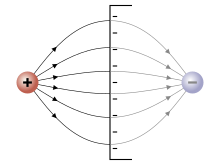Mirror charge
The image charge or image charge is a conceptual auxiliary support to the behavior of a charge Q in front of a conductive body or a dielectric interface at a distance R to illustrate. In the case of a conductor, the entire influenced charge is clearly summarized into a point charge . For reasons of symmetry, this point charge is referred to as a mirror charge . It is therefore a special case of the cargo center of gravity of an influenced cargo.
The corresponding principle of the mirror charge is a method for solving electrostatic boundary value problems .
Basics
If a conductive body is brought into an external electric field , the field lines are usually not yet perpendicular to the surface at the beginning . This leads to potential differences along the surface, which cause the freely moving electrons to shift in such a way that the field lines hit the surface perpendicularly (external electric fields decrease exponentially over time within conductive bodies). Since the external electric field also causes potential differences in the body, the electrons move within the body in such a way that the same potential prevails everywhere there. Theoretically, this leads to surface charge densities. Viewed microscopically close, the electrons keep a distance from one another and therefore the influence charges are always only very close to the surface, but are not real surface charges.
Since the electric field lines are perpendicular to the surface, the conductive body changes the electric field in such a way that its surface corresponds to an equipotential surface. For the mathematical treatment, a second electric field is introduced in addition to the existing external electric field with the boundary condition that the superimposed field is perpendicular to the surface. This is equivalent to the requirement that the electrical potential at the surface is constant everywhere, for the sake of simplicity it is equal to 0.
The reverse of this procedure is that for a given electric field, the field is cut off along the equipotential surfaces and conductive surfaces are placed there (of course, while maintaining the shape of the equipotential surface). Using the means of function theory, this procedure is a very powerful tool for solving certain boundary value problems.
Application examples
Metal plate
By induction , of the charge Q an opposite charge generated in the metal plate. The electric field lines and the Coulomb forces between the generating charge and the plate behave as if there were a charge - Q at a distance R behind the metal plate. The generating charge is thus - figuratively speaking - reflected on the metal surface.
Surface charges on the metal surface are assumed for the arrangement of the influenced charges. The charge density on the surface has its maximum at the point above which the charge Q is perpendicular and decreases radially outwards. Assuming an infinitely thin metal plate, the surface charge density can be given as a formula as follows:
Other conductive objects
With other conductive objects, such as a metal ball, the mirror surface does not necessarily lie on the surface. In most cases, however, a single, notional point charge can be constructed in which the entire charge can be imagined as a unit (center of gravity).
In the case of a conductive sphere with radius R , the mirror charge can be found via the inversion on the circle (thought to be reflection on the surface of the circle). The following applies to the distances between the mirror charge:
The following then applies to the amount of the mirrored charge :
Planar dielectric interface
A planar dielectric interface is given. In the medium with a dielectric constant, there is a charge in place . The charge is then imagined in the other medium . In the event that and in both media there are charges of the same name that repel each other. In the event that and the unlike charges attract each other. Therefore, charges that are in one dielectric are repelled by dielectric interfaces if the other dielectric has a lower dielectric constant. This behavior can also be understood by considering energy.
literature
- Karl Küpfmüller, Wolfgang Mathis, Albrecht Reibiger: Theoretical electrical engineering . 18th edition. Springer, 2008, ISBN 978-3-540-78589-7 , Chapter 10 - Simple examples of electrostatic fields.
Web links
- Animation of the mirror charge on a metal surface














